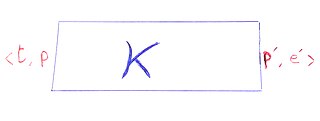Lambda calculus is a formal system in mathematical logic for expressing computation based on function abstraction and application using variable binding and substitution. It is a universal model of computation that can be used to simulate any Turing machine. It was introduced by the mathematician Alonzo Church in the 1930s as part of his research into the foundations of mathematics.

Scheme is a minimalist dialect of the Lisp family of programming languages. Scheme consists of a small standard core with several tools for language extension.
In software engineering and computer science, abstraction is:
In mathematics, and in other disciplines involving formal languages, including mathematical logic and computer science, a free variable is a notation (symbol) that specifies places in an expression where substitution may take place and is not a parameter of this or any container expression. Some older books use the terms real variable and apparent variable for free variable and bound variable, respectively. The idea is related to a placeholder, or a wildcard character that stands for an unspecified symbol.
Combinatory logic is a notation to eliminate the need for quantified variables in mathematical logic. It was introduced by Moses Schönfinkel and Haskell Curry, and has more recently been used in computer science as a theoretical model of computation and also as a basis for the design of functional programming languages. It is based on combinators which were introduced by Schönfinkel in 1920 with the idea of providing an analogous way to build up functions—and to remove any mention of variables—particularly in predicate logic. A combinator is a higher-order function that uses only function application and earlier defined combinators to define a result from its arguments.
In mathematics and computer science in general, a fixed point of a function is a value that is mapped to itself by the function.
In programming language theory and proof theory, the Curry–Howard correspondence is the direct relationship between computer programs and mathematical proofs.

In computer science, conditionals are programming language commands for handling decisions. Specifically, conditionals perform different computations or actions depending on whether a programmer-defined boolean condition evaluates to true or false. In terms of control flow, the decision is always achieved by selectively altering the control flow based on some condition.
In computer science, the funarg problem(function argument problem) refers to the difficulty in implementing first-class functions in programming language implementations so as to use stack-based memory allocation of the functions.
The SKI combinator calculus is a combinatory logic system and a computational system. It can be thought of as a computer programming language, though it is not convenient for writing software. Instead, it is important in the mathematical theory of algorithms because it is an extremely simple Turing complete language. It can be likened to a reduced version of the untyped lambda calculus. It was introduced by Moses Schönfinkel and Haskell Curry.
Lambda lifting is a meta-process that restructures a computer program so that functions are defined independently of each other in a global scope. An individual "lift" transforms a local function into a global function. It is a two step process, consisting of;
In computer programming, an anonymous function is a function definition that is not bound to an identifier. Anonymous functions are often arguments being passed to higher-order functions or used for constructing the result of a higher-order function that needs to return a function. If the function is only used once, or a limited number of times, an anonymous function may be syntactically lighter than using a named function. Anonymous functions are ubiquitous in functional programming languages and other languages with first-class functions, where they fulfil the same role for the function type as literals do for other data types.
In computer science, lambda calculi are said to have explicit substitutions if they pay special attention to the formalization of the process of substitution. This is in contrast to the standard lambda calculus where substitutions are performed by beta reductions in an implicit manner which is not expressed within the calculus; the "freshness" conditions in such implicit calculi are a notorious source of errors. The concept has appeared in a large number of published papers in quite different fields, such as in abstract machines, predicate logic, and symbolic computation.
The categorical abstract machine (CAM) is a model of computation for programs that preserves the abilities of applicative, functional, or compositional style. It is based on the techniques of applicative computing.
A Böhm tree is a tree-like mathematical object that can be used to provide denotational semantics for terms of the lambda calculus. It is named after Corrado Böhm.
In computer science, a "let" expression associates a function definition with a restricted scope.
In rewriting, a reduction strategy or rewriting strategy is a relation specifying a rewrite for each object or term, compatible with a given reduction relation. Some authors use the term to refer to an evaluation strategy.
Deductive lambda calculus considers what happens when lambda terms are regarded as mathematical expressions. One interpretation of the untyped lambda calculus is as a programming language where evaluation proceeds by performing reductions on an expression until it is in normal form. In this interpretation, if the expression never reduces to normal form then the program never terminates, and the value is undefined. Considered as a mathematical deductive system, each reduction would not alter the value of the expression. The expression would equal the reduction of the expression.
Lambda calculus is a formal mathematical system based on lambda abstraction and function application. Two definitions of the language are given here: a standard definition, and a definition using mathematical formulas.

In theoretical computer science, the Krivine machine is an abstract machine. As an abstract machine, it shares features with Turing machines and the SECD machine. The Krivine machine explains how to compute a recursive function. More specifically it aims to define rigorously head normal form reduction of a lambda term using call-by-name reduction. Thanks to its formalism, it tells in details how a kind of reduction works and sets the theoretical foundation of the operational semantics of functional programming languages. On the other hand, Krivine machine implements call-by-name because it evaluates the body of a β-redex before it applies the body to its parameter. In other words, in an expression u it evaluates first λx. t before applying it to u. In functional programming, this would mean that in order to evaluate a function applied to a parameter, it evaluates first the function before applying it to the parameter.


